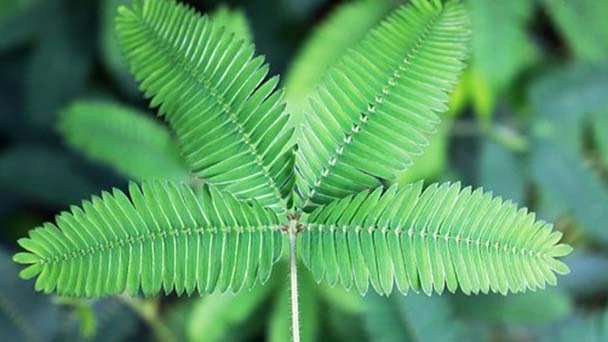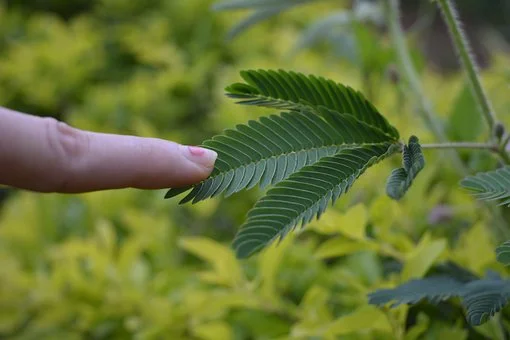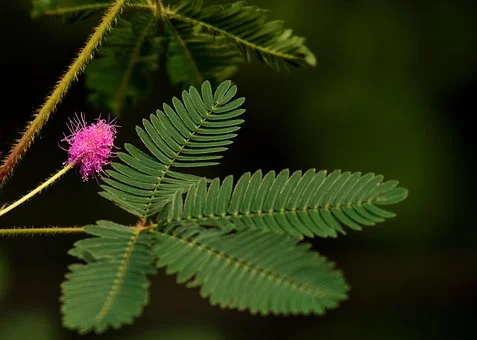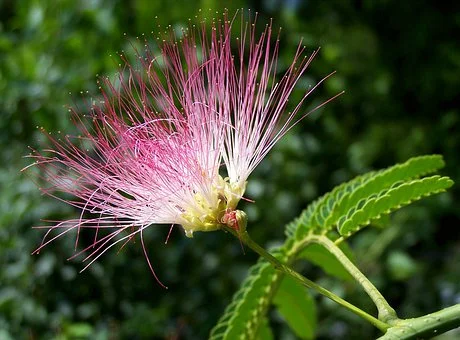How to Grow and Care for Sensitive Plant (Mimosa Pudica)
Written by Ivy
Nov 18 2021

Although Sensitive Plant (Mimosa Pudica) is very interesting, we should not touch the sensitive plant often. The whole plant of sensitive plant contains a trace of toxin, which is called mimosamine. If long-term contact, it will make people's hair dry and even lose hair. Moreover, it will send toxic substances into the air at night, which is very bad for people's health. Therefore, it is better not to put sensitive plant in indoor propagation.

Spring is the season for the recovery of all things. Sensitive plant has a high demand for water. During planting, water the plant once a day and thoroughly every time. At this time, fertilizer should be applied to the plant every three days. The temperature is high in summer. When planting sensitive plant, we can water the plant every two days and spray water around the plant properly at ordinary times.
For the sensitive plant ornamental potted plants, in addition to the main branches, if there are too many side branches, it is easy to cause a lot of nutrient consumption, and will also affect the beauty of its plant type. Therefore, we need to trim some side branches of the sensitive plant in time to maintain a beautiful state.
We should comb the branches of sensitive plant regularly to cut off some branches that are too dense and grow too long. On the one hand, it also avoids wasting nutrients. On the other hand, it increases the ventilation and light transmittance of the whole plant, which is more conducive to its subsequent growth, making its branches strong and blooming.
The flowering period of sensitive plant is from July to September in summer. After the flowering period, we should cut off its residual flowers in time to avoid nutrient consumption and disease infection.
We can remove the original plant from the pot before changing the pot at sensitive plant. For example, you can knock the pot wall a few times with your hand to make it have a gap with the pot, and then press and turn it over to remove the pot. Retain the soil mass around the root system. If there are diseased roots and withered roots, they need to be trimmed, disinfected and dried with multi fungus solution. It likes to grow in relatively breathable, drainage and fertile soil rich in humus, so we can evenly mix and prepare one part of rotten leaf soil and one part of garden soil. Sensitive plant flowerpots can be larger, and ceramic pots, mud tiles and purple sand pots are preferred in material.
We can plant the sensitive plant in the sterilized new culture soil, compact the soil after covering, and keep the soil fixed. If the soil is relatively dry, we can water it appropriately to keep the basin soil moist. We should place the sensitive plant after changing the basin in a ventilated environment and wait for normal maintenance and management after its survival and growth are stable.
Sensitive Plant Quick InfoWhen to Plant Sensitive PlantWhen does Sage Plant Bloom & HarvestSensitive Plant Care in DetailSensitive Plant WateringSensitive Plant SoilSensitive Plant LightSensitive Plant TemperatureSensitive Plant HumiditySensitive Plant FertilizerSensitive Plant PruningSensitive Plant RepottingSensitive Plant Pest & Disease Control1. Leaf spot2. Rust3. StarscreamSensitive Plant Propagation from Seed1. Prepare seeds2. Planting sensitive plant seed3. Emergence propagation4. Seedling cultureSensitive Plant Benefits
Sensitive Plant Quick Info
| Botanical/Scientific Name | Mimosa Pudica |
| Common Name | Humble Plant |
| When to Grow/Bloom/Harvest | Bloom in mid-summer to early autumn |
| Uses | Medical uses |
| Origin | Central America and South America |
| Light Care | Bright light, some direct sunlight |
| Soil Care | Well-draining loamy soil |
| Temperature Care | Range of 60-85 F (16-30 C) |
| Humidity Care | Above 50% relative humidity |
| Watering | Water the potting soil thoroughly |
| Pruning Care | Regular pruning |
| Fertilizer Care | High-potassium liquid fertilizer diluted to half strength every few weeks |
| Propagation | Grown from seeds |
| Toxic | Slightly poisonous |
| Flower Color | Filaments are pink to lavender |

When to Plant Sensitive Plant
The sowing season of sensitive plant is in spring. Specifically, around March and April, when the temperature is basically stable, I like the warm environment. After sowing, sensitive plant seeds will emerge soon, with high survival rate and fast growth rate in the later stage. The sensitive plant sowing method is very simple. We just need to prepare loose and breathable soil, and then sprinkle the seeds evenly on it and cover it with a thin layer of soil. The seedlings can emerge in about a week.When does Sage Plant Bloom & Harvest
Sage plant usually blooms in midsummer. In the green grass, light purple and pink flowers, hairy, appear particularly shy. The slender branches and leaves set off the plump and round flowers more charming and bright. The flowering period of sage plant is from July to October. It takes about 5 days from bud to flowering. After flowering, pods will be formed in autumn, with seeds in them, and the internodes will fall off when they are mature.Sensitive Plant Care in Detail
Sensitive Plant Watering
Sensitive plant is native to the tropics. It likes to grow in a warm and humid environment and has low demand for water. When planting sensitive plant, we can water the plants according to the changes of seasons.Spring is the season for the recovery of all things. Sensitive plant has a high demand for water. During planting, water the plant once a day and thoroughly every time. At this time, fertilizer should be applied to the plant every three days. The temperature is high in summer. When planting sensitive plant, we can water the plant every two days and spray water around the plant properly at ordinary times.
Sensitive Plant Soil
Sensitive plant does not have high requirements for soil. Generally, garden soil and vegetable garden soil can be planted. If conditions permit, some loose and fertile humus mixed soil can be selected. Of course, sandy soil is also OK.Sensitive Plant Light
The sensitive plant should always be exposed to the sun. Under the condition of sufficient sunlight, the root system grows rapidly. If the light is too weak, the sensitive plant will grow weakly, and there will be bad flowering performance. At ordinary times, we should not put it in a too shady place, but see more sunshine.Sensitive Plant Temperature
Sensitive plant is a tropical crop. Sensitive plant is suitable to grow in a warm environment. It should be 20-28 degrees. If the temperature is too low, it will stop growing. In severe cases, it will suffer from normal freezing injury. In high temperature, the water evaporation will be large, which will cause water loss and wilting. Therefore, we should pay attention to watering management. The temperature should not be too low during the growth period. Too low temperature will stop its growth. If it is watered too much at this time, it will cause freezing damage to the roots and stems of sensitive plant. Therefore, once the temperature is lower than 10 ℃, we should take thermal insulation measures.Sensitive Plant Humidity
Sensitive plant likes a warm, humid and sunny environment. If it wants to plant, it should be considered in combination with the local climate and environment. It should be reminded that sensitive plant is slightly toxic. If exposed for a long time, it will cause hair and eyebrows to turn yellow or even fall off.Sensitive Plant Fertilizer
We can apply topdressing once every half a month at the seedling stage of sensitive plant. If we don't want the plant shape to be too large, we should reduce the amount of fertilization. The leaflets of sensitive plant are small and arranged in a feather shape. After shaking hands and touching the leaflets, they will be closed immediately. If the vibration is large, the stimulation can be transmitted to the whole leaf, and the total petiole will sag, or even to the adjacent leaves to make the petiole sag.
Sensitive Plant Pruning
During the propagation of sensitive plant, in order to avoid its overgrowth and affect the beauty of plant type, we should properly remove its top bud at the initial stage of growth. Cut off the top branches and make them develop in a low and strong shape, which will be more conducive to its subsequent growth and more beautiful.For the sensitive plant ornamental potted plants, in addition to the main branches, if there are too many side branches, it is easy to cause a lot of nutrient consumption, and will also affect the beauty of its plant type. Therefore, we need to trim some side branches of the sensitive plant in time to maintain a beautiful state.
We should comb the branches of sensitive plant regularly to cut off some branches that are too dense and grow too long. On the one hand, it also avoids wasting nutrients. On the other hand, it increases the ventilation and light transmittance of the whole plant, which is more conducive to its subsequent growth, making its branches strong and blooming.
The flowering period of sensitive plant is from July to September in summer. After the flowering period, we should cut off its residual flowers in time to avoid nutrient consumption and disease infection.
Sensitive Plant Repotting
Sensitive plant repotting is an important step. Generally speaking, sensitive plant needs to change pots every 1-2 years, and the appropriate time should be selected. From its growth habits, because it likes to grow in a warm and humid environment, it is best to change pots in spring, with fast growth and high survival rate.We can remove the original plant from the pot before changing the pot at sensitive plant. For example, you can knock the pot wall a few times with your hand to make it have a gap with the pot, and then press and turn it over to remove the pot. Retain the soil mass around the root system. If there are diseased roots and withered roots, they need to be trimmed, disinfected and dried with multi fungus solution. It likes to grow in relatively breathable, drainage and fertile soil rich in humus, so we can evenly mix and prepare one part of rotten leaf soil and one part of garden soil. Sensitive plant flowerpots can be larger, and ceramic pots, mud tiles and purple sand pots are preferred in material.
We can plant the sensitive plant in the sterilized new culture soil, compact the soil after covering, and keep the soil fixed. If the soil is relatively dry, we can water it appropriately to keep the basin soil moist. We should place the sensitive plant after changing the basin in a ventilated environment and wait for normal maintenance and management after its survival and growth are stable.
Sensitive Plant Pest & Disease Control
1. Leaf spot
The sensitive plant disease is caused by the infection of semiknow bacteria, which makes the leaves of Mimosa appear sick spots. After the onset of the disease, we should immediately spray chlorothalonil on the leaves for treatment.2. Rust
The sensitive plant disease is caused by rust parasitism in fungi and mainly endangers leaves and stems. We can spray diseased strains with mancozeb or chlorothalonil.3. Starscream
The sensitive plant disease endangers the leaves of plants with adults, nymphs and larvae. We can spray Omethoate or dicofol 800-1000 times.
Sensitive Plant Propagation from Seed
Because sensitive plant is special, it cannot carry out cutting or branch propagation, so there is only one method of propagation, that is, sensitive plant propagation from seed. Although this method is difficult, it can also experience different fun in the process of propagation.1. Prepare seeds
Sensitive plant can reproduce in spring and autumn. Before planting, it should be soaked in warm water at 35-40 ℃ for one day; Pot soil shall be mixed with rotten leaf soil, garden soil and fine yellow sand. We can add an appropriate amount of culture soil to the basin soil, flatten the surface of the basin soil, and then sprinkle the water with a watering can. After all the water penetrates, we can plant.2. Planting sensitive plant seed
We can plant 1 ~ 2 seeds in each pot. If the seedling is propagated in a shallow basin, it shall be 2cm × On demand at a distance of 2cm. Cover the soil 3 ~ 5cm after sowing, and cover the seeds. Cover the basin with glass or plastic film for moisturizing, and put the basin at the astigmatism of about 20 ℃. Later, when the basin soil is dry, use the immersion basin method for irrigation. After about 7 ~ 10 days, the seeds germinate and emerge.3. Emergence propagation
After sensitive plant seedlings emerge, we should remove the cover from the basin and gradually accept the sun. When the seedlings grow to 3cm high, those sown in a shallow basin can be transplanted separately. Seedlings should be transplanted with soil, otherwise it is not easy to survive. After the seedlings just put into the basin are watered, put them in the semi shade first, and then move them to a sunny place after the seedlings are slow.4. Seedling culture
Sensitive plant propagation from seed can be carried out all year round, but it is best to sow indoors in early spring and February. We can wait until the sensitive plant seedlings grow to 5-6cm high, plant them separately with soil balls, and then plant them in larger pots when they grow to 10cm.Sensitive Plant Benefits
Cooling blood and detoxifying and clearing heat and dampness are the medicinal effects of sensitive plant. They can be used to treat high fever, tracheitis, hepatitis, enteritis, edema and other diseases. The therapeutic effect is very excellent. Sensitive plant can clear away heat and detoxify. Sensitive plant has a good therapeutic effect on human neurasthenia after it is used as medicine. Sensitive plant can also stop bleeding. It has a good therapeutic effect on diseases such as hemoptysis, hematemesis and hematuria.Latest Updated
- Benefits of Bugleweed - 7 Science-backed Health Benefits
- Bugleweed Dangers & Side Effects - Is It Poisonous?
- How to Plant Evergreen Trees - What You Should Know
- When to Plant Evergreens - Grow Guide for Evergreen Trees
- 12 Wonderful Evergreen Shrubs for Your Garden
- 12 Popular Evergreen Plants with Pictures for Beginners
- When And How To Prune A Lilac Bush Like a Pro
- How to Grow & Care for Lilac Vine (Hardenbergia Violacea)
- Japanese Lilac Tree (Syringa Reticulata) Care & Propagation Guide
- Shumard Oak Pros and Cons - What to Know
Popular Articles
- Winter maintenance of Antirrhinum Majus
- How to Grow Terminalia Mantaly Tree
- How to Grow and Care for Crossostephium Chinense
- How to grow Antirrhinum Majus in spring
- Peristeria Elata (Dove Orchid) Profile: Info & Care Guide
- Underwatered Snake Plant (Sansevieria Trifasciata) - Signs And How To Fix
- How to Care for Brazilian Jasmine Plant (Mandevilla Sanderi)
- How to Grow & Care for Graptopetalum Purple Delight in Summer
- Rosa Chinensis (China Rose): Plant Growing & Care Tips
- How to Care for Baby Sun Rose (Aptenia Cordifolia)